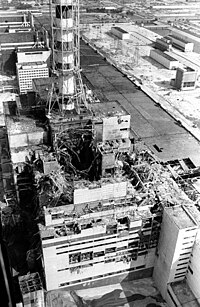
Photo from wikipedia
Abstract Reactivity of atmospherically deposited nitrate (NO3−) and ammonium (NH4+) was investigated in three mountain forest catchments and one ombrotrophic peat bog located in the northern Czech Republic. The study… Click to show full abstract
Abstract Reactivity of atmospherically deposited nitrate (NO3−) and ammonium (NH4+) was investigated in three mountain forest catchments and one ombrotrophic peat bog located in the northern Czech Republic. The study sites are characterized by moderate to high N pollution rates that are currently decreasing. Monitoring of hydrodynamic data and catchment hydrochemistry (precipitation, soil solutions and runoff) was complemented by δ15N analyses of dissolved inorganic N (NO3−, NH4+). Measured δ 15N data were used to calculate the extent of biogeochemical reactions and to construct N mass balances. Two-component models of runoff generation were developed using hydrological and δ18O–H2O data on local precipitation, runoff, and soil waters collected by lysimeters. Catchment discharge was formed by groundwater (60–80%) and storm precipitation (40–20%), with minimal time lags. Groundwater had a diluting effect on reactions proceeding in the soil zone, including nitrification and denitrification. The rates of nitrification were estimated by comparing the δ15N values of atmospheric input and soil water, while the rates of denitrification were derived from the differences in the δ15N values of soil water and stream discharge. The Ν isotope effect of mineralisation of organic N was assessed by comparing δ15N values of soil and soil extracts. Nitrogen release from the catchments was controlled by temperature-dependent seasonality of soil reactions. Atmospheric N entered the runoff directly only during a short late winter - early spring period, accounting for approximately 10% of the total N input. Important inputs of mineralised organically cycled soil N were observed at the beginning and the end of the growing season, with measurable denitrification occurring during the same time periods. The measured apparent N isotope fractionations were significantly lower than previously published values (−3 to −14‰ vs. −30‰ for nitrification, and −3 vs. −20‰ for denitrification). Lower 15N fractionations originated both from the dilution effect of groundwater on stream discharge and from the depletion of available ammonium during nitrification reactions. Denitrification proceeding during recharge of the groundwater body was estimated from the difference in the δ15N values of NO3− in precipitation and groundwater.
Journal Title: Applied Geochemistry
Year Published: 2020
Link to full text (if available)
Share on Social Media: Sign Up to like & get
recommendations!